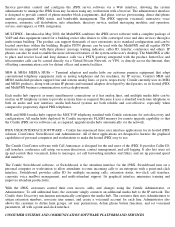8x8 2002 Annual Report Download - page 19
Download and view the complete annual report
Please find page 19 of the 2002 8x8 annual report below. You can navigate through the pages in the report by either clicking on the pages listed below, or by using the keyword search tool below to find specific information within the annual report.developing its third product line that includes consumer telephones, videophones, and communication software and
services that work over broadband networks, at the parent company level. 8x8 sells videophones that work over normal
phone lines and is planning to initiate trials of its IP telephony software and service offering that is designed to enable
customers to communicate with IP telephones and videophones using an Internet based communications software
platform and service.
CRITICAL ACCOUNTING POLICIES
The Company's consolidated financial statements are prepared in conformity with accounting principles generally
accepted in the United States. The Company does not have any ownership interest in any special purpose entities that
are not wholly-owned and consolidated subsidiaries of the Company.
We have identified the policies below as some of the most critical to our business and the understanding of our results
of operations. These policies require critical judgments and estimates about matters that are inherently uncertain.
Although we believe our judgments and estimates are appropriate and correct, actual future results may differ from our
estimates. The impact and any associated risks related to these policies on our business operations is discussed
throughout Management's Discussion and Analysis of Financial Condition and Results of Operations where such
policies affect our reported and expected financial results. For a detailed discussion of the application of these and other
accounting policies, see Note 1 to the consolidated financial statements in Part II, Item 8 of this Report.
Use of estimates
The preparation of our consolidated financial statements, in conformity with accounting principles generally accepted
in the United States, requires management to make estimates and assumptions that affect the reported amounts of
assets, liabilities and equity and disclosure of contingent assets and liabilities at the date of the financial statements and
the reported amounts of revenues and expenses during the reporting period. These estimates, particularly estimates
relating to litigation and other contingencies, have a material impact on our financial statements, and are discussed in
detail throughout our analysis of the results of operations.
In addition to evaluating estimates relating to the items discussed above, we also consider other estimates, including,
but not limited to, those related to bad debts, the valuation of inventories, goodwill, income taxes, and financing
operations. We base our estimates on historical experience and on various other assumptions that are believed to be
reasonable under the circumstances, the results of which form the basis for making judgments about the carrying value
of assets, liabilities and equity that are not readily apparent from other sources. Actual results could differ from those
estimates under different assumptions or conditions. Additional information regarding risk factors that may impact our
estimates is included below under "Factors that May Affect Future Results."
Revenue recognition
Our revenue recognition policies are described in Note 1 to the consolidated financial statements in Part II, Item 8 of
this Report. As described below, significant management judgments and estimates must be made and used in
connection with the revenue recognized in any accounting period. Material differences may result in the amount and
timing of our revenue for any period if our management made different judgments or utilized different estimates.
At the time of each revenue transaction we assess whether the revenue amount is fixed and determinable and whether
or not collection is reasonably assured. We assess whether the fee is fixed and determinable based on the payment
terms associated with the transaction. If a significant portion of a fee is due after our normal payment terms, which are
thirty to ninety days from invoice date, we account for the fee as not being fixed and determinable. In these cases, we
recognize revenue as the fees become due. We assess collection based on a number of factors, including past
transaction history with the customer and the credit-
worthiness of the customer. We generally do not request collateral
from our customers. If we determine that collection of a fee is not reasonably assured, we defer the fee and recognize
revenue at the time collection becomes reasonably assured, which is generally upon receipt of cash.
For arrangements with multiple obligations (for example, undelivered maintenance and support), we allocate revenue to
each component of the arrangement using the residual value method based on the fair value of the undelivered
elements, which is specific to the Company. This means that we defer revenue from the arranged fee that is equivalent
























